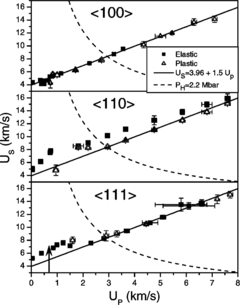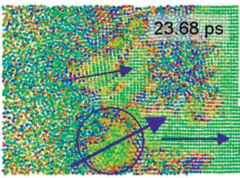Atomistic modeling of shock-induced void collapse in copper
L. P. Dávila,
P. Erhart,
E. M. Bringa,
M. A. Meyers,
V. A. Lubarda,
M. S. Schneider,
R. Becker,
and
M. Kumar
Applied Physics Letters 86, 161902
(2005)
doi: 10.1063/1.1906307
Download PDF
Nonequilibrium molecular-dynamics (MD) simulations show that shock-induced void collapse in copper occurs by emission of shear loops. These loops carry away the vacancies which comprise the void. The growth of the loops continues even after they collide and form sessile junctions, creating a hardened region around the collapsing void. The scenario seen in our simulations differs from current models that assume that prismatic loop emission is responsible for void collapse. We propose a dislocation-based model that gives excellent agreement with the stress threshold found in the MD simulations for void collapse as a function of void radius.

